Pricing Guides & Dictionary of Makers Marks for Antiques & Collectibles

ANTIQUE AND COLLECTIBLE FABERGE:
The Art of Imperial Russia
Join the most updated and complete collectibles research online - Learn more...
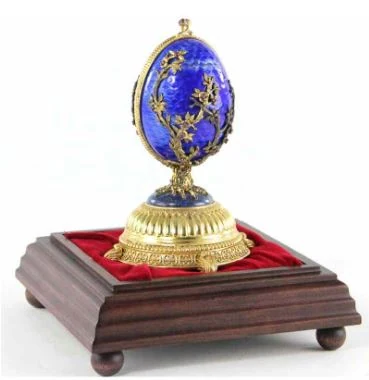 Faberge is a name that is synonymous with luxury, elegance, and craftsmanship. For more than a century, the creations of Carl Faberge and his team of skilled artisans have captivated collectors and enthusiasts around the world. From the famous Imperial Easter Eggs to the exquisite jewelry and decorative objects, Faberge pieces are highly sought-after and prized possessions.
Faberge is a name that is synonymous with luxury, elegance, and craftsmanship. For more than a century, the creations of Carl Faberge and his team of skilled artisans have captivated collectors and enthusiasts around the world. From the famous Imperial Easter Eggs to the exquisite jewelry and decorative objects, Faberge pieces are highly sought-after and prized possessions.
- The Legacy of Carl Faberge - Carl Faberge was born in St. Petersburg, Russia, in 1846, into a family of French Huguenot origins. His father, Gustav Faberge, was a successful jeweler who ran a small workshop in the city. Carl Faberge joined his father's workshop at the age of 24 and quickly established himself as a talented and innovative designer. In 1885, he was appointed court jeweler to Tsar Alexander III and soon became known for his exquisite creations.
- The Faberge Eggs - The Faberge eggs are perhaps the most famous of all Faberge creations. These jeweled eggs were commissioned by the Russian imperial family as Easter gifts for their loved ones. The first Faberge egg was created in 1885 for Tsar Alexander III, who wanted to give his wife, Empress Maria Feodorovna, a special Easter gift. The egg was made of gold and enamel and contained a small golden hen, which in turn contained a diamond miniature of the imperial crown. The success of this first egg led to the creation of many more, and over the years, a total of 50 Imperial Easter Eggs were made, each one a unique masterpiece of craftsmanship.
- The Faberge Workshop - The Faberge workshop was a center of excellence for jewelry and decorative arts. Carl Faberge and his team of skilled craftsmen used the finest materials and techniques to create their exquisite pieces. The workshop employed goldsmiths, enamelers, gem cutters, and other specialists, each of whom was a master of their craft. Many of the pieces created in the workshop were one-of-a-kind or limited editions, and each piece was signed and numbered by Faberge.
Collecting Faberge
Collecting Faberge pieces is a passion shared by many around the world. The beauty, rarity, and historical significance of these pieces make them highly sought-after, and owning a Faberge piece is considered the ultimate status symbol. Here are some tips for collectors:
- Research and Education - Before beginning a Faberge collection, it's important to do your research and learn as much as you can about the different types of pieces, their history, and their value. Attend auctions and exhibitions, read books and articles, and join collector groups to get a better understanding of the market and the pieces available.
- Quality and Authenticity - When buying Faberge pieces, it's essential to ensure that they are of the highest quality and authenticity. Look for pieces that are signed by Faberge and have a provenance that can be traced back to the Imperial era. Beware of replicas and fakes, which are often sold as authentic pieces. Work with reputable dealers and auction houses, and get pieces authenticated by experts before making a purchase.
- Diversify Your Collection - Collecting Faberge doesn't have to be limited to just one type of piece. Diversifying your collection can be both fun and rewarding. Consider collecting a variety of Faberge pieces, including eggs, jewelry, snuff boxes, and other decorative objects. This can make your collection more interesting and varied, and it can also increase its value over time.
- Display and Care - Once you have acquired your Faberge pieces, it's important to display them properly and take good care of them. Keep them out of direct sunlight and away from heat sources, as this can damage the materials and reduce their value. Use acid-free paper and materials for storage, and handle them with care to avoid scratches and other damage.
The Future of Faberge Collecting
As the world becomes increasingly digital, the way we collect and appreciate art and antiques is changing. While traditional methods such as auctions and exhibitions will always have a place in the world of Faberge collecting, new technologies are providing collectors with new opportunities to view, learn about, and acquire these pieces.
One such technology is virtual reality (VR). VR allows collectors to view Faberge pieces in 3D and to see the details and craftsmanship up close. This can be especially valuable for collectors who are unable to attend exhibitions in person or who want to get a closer look at pieces before making a purchase.
Another technology that is transforming the world of Faberge collecting is blockchain. Blockchain is a secure, decentralized ledger that can be used to verify the authenticity and ownership of Faberge pieces. This technology can provide collectors with greater confidence and transparency when buying and selling these pieces, and it can also help to prevent fraud and forgery.
In conclusion, collecting Faberge pieces is a passion that has captivated enthusiasts for over a century. The beauty, rarity, and historical significance of these pieces make them highly sought-after and prized possessions. If you are interested in starting a Faberge collection, be sure to do your research, work with reputable dealers and auction houses, and take good care of your pieces. And with new technologies such as VR and blockchain, the future of Faberge collecting looks brighter than ever.
Unlock the true value of your collection with our comprehensive research guides from identifying makers' marks to appraising all kinds of antiques and collectibles, including items featured in this article.
Our up-to-date information will give you an accurate understanding of your items' worth. Don't miss out on this valuable resource - visit our research tools today!
In addition to some examples shown below on this page, you can also search our price guide for your own treasures.
Examples of related items from our Price Guides
-
 Eleven Books on Faberge and Russian Arts
[more like this]
Eleven Books on Faberge and Russian Arts
[more like this]
-
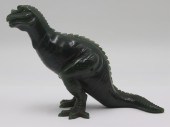 FABERGE. CARVED NEPHRITE DINOSAUR WITH D
[more like this]
FABERGE. CARVED NEPHRITE DINOSAUR WITH D
[more like this]
-
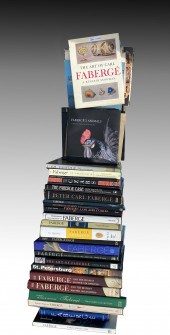 40 PC. COLLECTION OF BOOKS ON FABERGE: I
[more like this]
40 PC. COLLECTION OF BOOKS ON FABERGE: I
[more like this]
-
 FABERGE LIMOGES BLUE EGG PLUS WINE CHARM
[more like this]
FABERGE LIMOGES BLUE EGG PLUS WINE CHARM
[more like this]
-
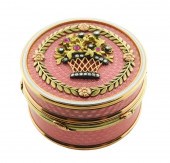 FABERGE STYLE MINIATURE PILL BOX, ROUND
[more like this]
FABERGE STYLE MINIATURE PILL BOX, ROUND
[more like this]
-
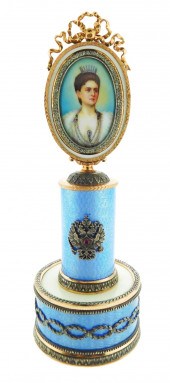 FABERGE STYLE MINIATURE PAINTING IN ENAM
[more like this]
FABERGE STYLE MINIATURE PAINTING IN ENAM
[more like this]
-
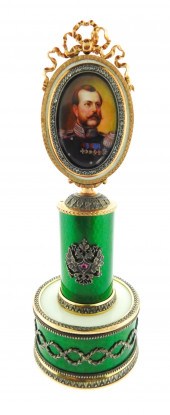 FABERGE STYLE MINIATURE PAINTING IN ENAM
[more like this]
FABERGE STYLE MINIATURE PAINTING IN ENAM
[more like this]
-
 JEWELRY. FABERGE 18KT GOLD, ENAMEL AND D
[more like this]
JEWELRY. FABERGE 18KT GOLD, ENAMEL AND D
[more like this]
-
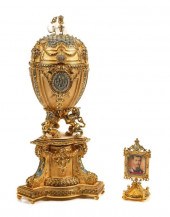 FABERGE ROYAL DANISH JUBILEE EGGYellow a
[more like this]
FABERGE ROYAL DANISH JUBILEE EGGYellow a
[more like this]
-
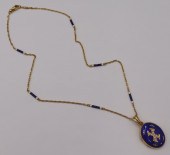 JEWELRY. FABERGE 18KT GOLD BLUE ENAMEL A
[more like this]
JEWELRY. FABERGE 18KT GOLD BLUE ENAMEL A
[more like this]
-
 GROUP OF ELEVEN FABERGE GLASSES, TO INCL
[more like this]
GROUP OF ELEVEN FABERGE GLASSES, TO INCL
[more like this]
-
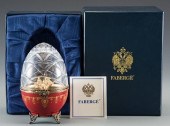 FABERGE LIMOGES CHRISTMAS EGGHouse of Fa
[more like this]
FABERGE LIMOGES CHRISTMAS EGGHouse of Fa
[more like this]
There are many more auction results available to our members...





